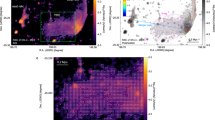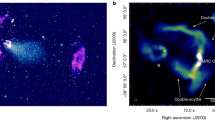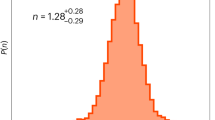Abstract
The relative orientation of the axes of extragalactic extended radio sources was first investigated by Willson1, who noted that in the 3CR sample there was a tendency for the axes to lie parallel to each other for sources separated by ≲10° on the sky. Using two larger samples, Sanders2 has recently concluded that this tendency to align is present at a high confidence level (>3σ) only for distant (redshift, z>0.4) sources and could arise from gravitational lensing by superclusters, if most of the matter in a closed universe is in thin filaments2,3. Because of the important cosmological implications, we have now attempted to verify the effect using two more independent and larger source samples and find no significant tendency for axis alignment. In view of this negative result, we also investigated a sample formed by adding well-observed radio quasars to 3CR sources (similar to one of the two samples used by Sanders) and found that, even in this sample, the effect shows up only at a marginally significant level (<2σ).
This is a preview of subscription content, access via your institution
Access options
Subscribe to this journal
Receive 51 print issues and online access
$199.00 per year
only $3.90 per issue
Buy this article
- Purchase on Springer Link
- Instant access to full article PDF
Prices may be subject to local taxes which are calculated during checkout
Similar content being viewed by others
References
Willson, M. A. G. Mon. Not. R. astr. Soc. 155, 275–282 (1972).
Sanders, R. H. Nature 309, 35–37 (1984).
Sanders, R. H., van Albada, T. S. & Oosterloo, T. Astrophys. J. 278, L91–L94 (1984).
Joshi, M. N. & Singal, A. K. Mem. astr. Soc. India 1, 49–72 (1980).
Machalski, J. & Maslowski, J. Astr. J. 87, 1132–1149 (1982).
Machalski, J., Maslowski, J., Condon, J. J. & Condon, M. A. Astr. J. 87, 1150–1164 (1982).
Machalski, J. & Condon, J. J. Astr. J. 88, 143–160 (1983).
Laing, R. A., Riley, J. M. & Longair, M. S. Mon. Not. R. astr. Soc. 204, 151–187 (1983).
Fanaroff, B. L. & Riley, J. M. Mon. Not. R. astr. Soc. 167, 31P–35P (1974).
Hintzen, P., Ulvestad, J. & Owen, F. Astr. J. 88, 709–758 (1983).
Miley, G. K. & Hartsuijker, A. Astr. Astrophys. Suppl. 34, 129–163 (1978).
Potash, R. I. & Wardle, J. F. C. Astr. J. 84, 707–717 (1979).
Stannard, D. & Neal, D. S. Mon. Not. R. astr. Soc. 179, 719–740 (1977).
Owen, F. N., Porcas, R. W. & Neff, S. G. Astr. J. 83, 1009–1020 (1978).
Wills, D. Astrophys. J. Suppl. 39, 291–315 (1979).
Author information
Authors and Affiliations
Rights and permissions
About this article
Cite this article
Kapahi, V., Subrahmanyan, R. & Singal, A. The alignment of distant radio sources. Nature 313, 463–465 (1985). https://doi.org/10.1038/313463a0
Received:
Accepted:
Issue Date:
DOI: https://doi.org/10.1038/313463a0
This article is cited by
Comments
By submitting a comment you agree to abide by our Terms and Community Guidelines. If you find something abusive or that does not comply with our terms or guidelines please flag it as inappropriate.



